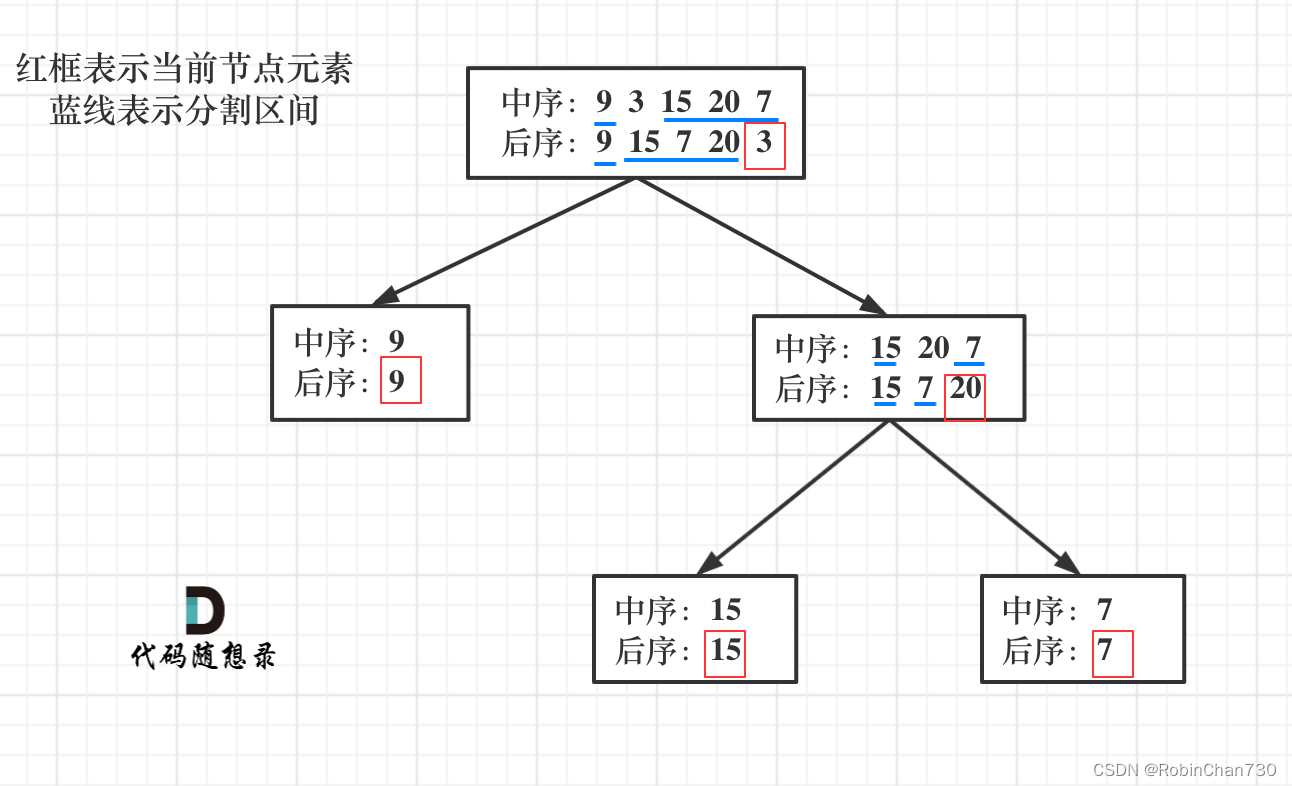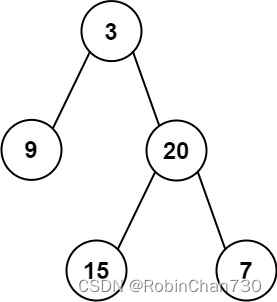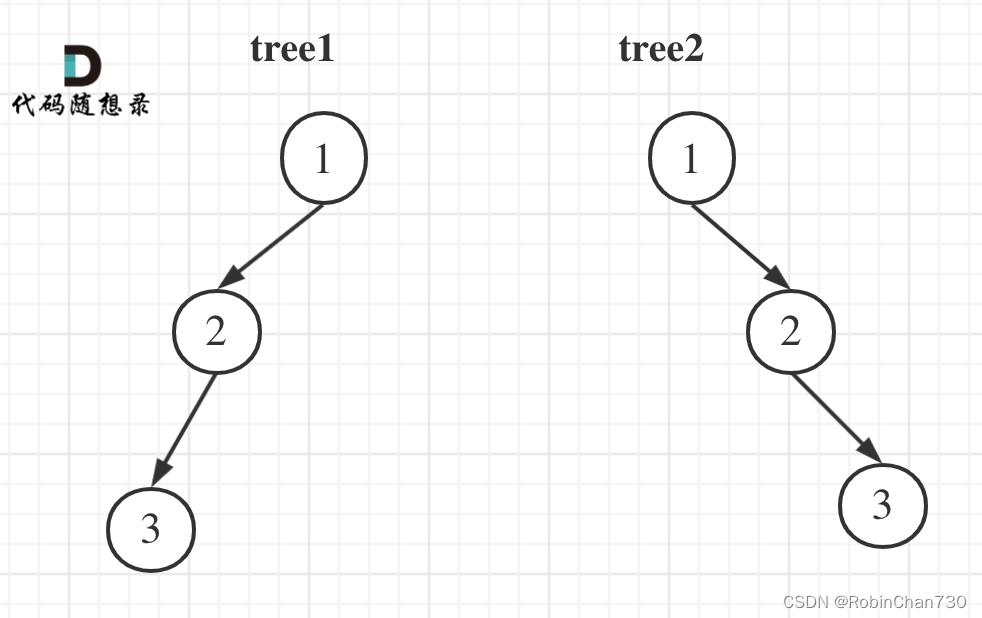力扣日记12.13-【二叉树篇】从中序与后序遍历序列构造二叉树
2023-12-13 16:01:05
力扣日记:【二叉树篇】从中序与后序遍历序列构造二叉树
日期:2023.12.13
参考:代码随想录、力扣
106. 从中序与后序遍历序列构造二叉树
题目描述
难度:中等
给定两个整数数组 inorder 和 postorder ,其中 inorder 是二叉树的中序遍历, postorder 是同一棵树的后序遍历,请你构造并返回这颗 二叉树 。
示例 1:

输入:inorder = [9,3,15,20,7], postorder = [9,15,7,20,3]
输出:[3,9,20,null,null,15,7]
示例 2:
输入:inorder = [-1], postorder = [-1]
输出:[-1]
提示:
- 1 <= inorder.length <= 3000
- postorder.length == inorder.length
- -3000 <= inorder[i], postorder[i] <= 3000
- inorder 和 postorder 都由 不同 的值组成
- postorder 中每一个值都在 inorder 中
- inorder 保证是树的中序遍历
- postorder 保证是树的后序遍历
题解
/**
* Definition for a binary tree node.
* struct TreeNode {
* int val;
* TreeNode *left;
* TreeNode *right;
* TreeNode() : val(0), left(nullptr), right(nullptr) {}
* TreeNode(int x) : val(x), left(nullptr), right(nullptr) {}
* TreeNode(int x, TreeNode *left, TreeNode *right) : val(x), left(left), right(right) {}
* };
*/
class Solution {
# define SOLUTION 2
public:
# if SOLUTION == 1
TreeNode* buildTree(vector<int>& inorder, vector<int>& postorder) {
// 递归返回值与参数:返回值为中节点, 参数为中序和后序数组
// 从中序与后序遍历序列构造二叉树的步骤
// 1. 如果后序数组为空, 则为空节点(终止条件)
if (postorder.size() == 0) return nullptr; // 为空节点
// 2. 根据后序数组最后一个值得到中节点值
int nodeVal = postorder[postorder.size() - 1]; // 后序数组最后一个值为中节点值
TreeNode* node = new TreeNode(nodeVal); // 构造中节点
// 注意如果是叶子节点, 则不需要再去切割, 直接返回当前节点
if (postorder.size() == 1) return node;
// 3. 寻找中序数组位置作切割点
int index = 0;
for (int i = 0; i < inorder.size(); i++) {
if (inorder[i] == nodeVal) {
index = i;
// index 为中节点值对应序号, 则[0, index)为左子树, [index + 1, size)为右子树, 注意统一区间开闭
}
}
// 4. 根据此切割点对中序数组进行切割
vector<int> inorderLeft(inorder.begin(), inorder.begin() + index); // [0, index)
vector<int> inorderRight(inorder.begin() + index + 1, inorder.end()); // [index + 1, size)
// 5. 再根据切割后中序数组左右区间长度对后序数组进行切割
vector<int> postorderLeft(postorder.begin(), postorder.begin() + inorderLeft.size()); // [0, left.size)
vector<int> postorderRight(postorder.begin() + inorderLeft.size(), postorder.begin() + inorderLeft.size() + inorderRight.size()); // [left.size, left.size + right.size)
// 6. 将中序数组与后序数组的左子树区间进行递归处理, 递归返回值为左子树的根节点,作为当前node左节点
node->left = buildTree(inorderLeft, postorderLeft); // 中序和后序的左子树遍历数组都分别按中序和后序遍历
// 7. 将中序数组与后序数组的右子树区间进行递归处理
node->right = buildTree(inorderRight, postorderRight);
return node; // 返回已经接上左右节点的中节点
}
# elif SOLUTION == 2 // 优化:用下标索引,不需要每次构建子数组
TreeNode* buildTree(vector<int>& inorder, vector<int>& postorder) {
int inorderBegin = 0, inorderEnd = inorder.size(); // [0, size)
int postorderBegin = 0, postorderEnd = postorder.size(); // [0, size)
return traversal(inorder, inorderBegin, inorderEnd, postorder, postorderBegin, postorderEnd);
}
TreeNode* traversal (vector<int>& inorder, int inorderBegin, int inorderEnd, vector<int>& postorder, int postorderBegin, int postorderEnd) {
// 递归返回值与参数:返回值为中节点, 参数为原始中序后序数组, 以及用来表示当前中后序数组的下标
// 不变量:左闭右开
// 从中序与后序遍历序列构造二叉树的步骤
// 1. 如果当前后序数组为空, 则为空节点(终止条件)
if (postorderEnd - postorderBegin == 0) return nullptr; // 为空节点 [Begin, Begin)
// 2. 根据后序数组最后一个值得到中节点值
int nodeVal = postorder[postorderEnd - 1]; // 后序数组最后一个值为中节点值, 右开, 则需-1
TreeNode* node = new TreeNode(nodeVal); // 构造中节点
// 注意如果是叶子节点, 则不需要再去切割, 直接返回当前节点
if (postorderEnd - postorderBegin == 1) return node;
// 3. 寻找中序数组位置作切割点
int index = 0;
for (int i = inorderBegin; i < inorderEnd; i++) {
if (inorder[i] == nodeVal) {
index = i;
// index 为中节点值对应序号, 则[inorderBegin, index)为左子树, [index + 1, inorderEnd)为右子树, 注意统一区间开闭
}
}
// 4. 根据此切割点对中序数组进行切割
int inorderLeftBegin = inorderBegin; // 左子树区间的开始下标(左闭)
int inorderLeftEnd = index; // 左子树区间的结束下标(右开)
int inorderRightBegin = index + 1; // 右子树区间
int inorderRightEnd = inorderEnd;
// 5. 再根据切割后中序数组左右区间长度对后序数组进行切割
int LeftSize = inorderLeftEnd - inorderLeftBegin; // 左子树大小
int postorderLeftBegin = postorderBegin;
int postorderLeftEnd = postorderBegin + LeftSize; // 后序与中序的左子树数组大小一致, LeftSize: [postorderLeftBegin, postorderLeftBegin + LeftSize)
int RightSize = inorderRightEnd - inorderRightBegin;
int postorderRightBegin = postorderLeftEnd; // 左闭
int postorderRightEnd = postorderLeftEnd + RightSize;
// 6. 将中序数组与后序数组的左子树区间进行递归处理, 递归返回值为左子树的根节点,作为当前node左节点
node->left = traversal(inorder, inorderLeftBegin, inorderLeftEnd, postorder, postorderLeftBegin, postorderLeftEnd); // 中序和后序的左子树遍历数组都分别按中序和后序遍历
// 7. 将中序数组与后序数组的右子树区间进行递归处理
node->right = traversal(inorder, inorderRightBegin, inorderRightEnd, postorder, postorderRightBegin, postorderRightEnd);
return node; // 返回已经接上左右节点的中节点
}
# endif
};
复杂度
时间复杂度:
空间复杂度:
思路总结
- 从中序与后序遍历序列构造二叉树的步骤
-
- 如果后序数组为空, 则为空节点
- 根据后序数组最后一个值得到中节点值
- 寻找中序数组位置作切割点
- 根据此切割点对中序数组进行切割
- 再根据切割后中序数组左右区间长度对后序数组进行切割
- 将中序数组与后序数组的左子树区间进行递归处理(两个左子树区间数组分别为左子树的中序数组和后序数组)
- 将中序数组与后序数组的右子树区间进行递归处理
-
- 示意图

- 对于第二种解法,即用下标索引表示子数组(而不是直接构造子数组),要分别确定好左右子树的中序和后序数组的开始、结束下标。统一用左闭右开来表示。相对繁琐一些,但时间和空间复杂度更优化。
相关题目:105. 从前序与中序遍历序列构造二叉树
题目描述
难度:中等
给定两个整数数组 preorder 和 inorder ,其中 preorder 是二叉树的先序遍历, inorder 是同一棵树的中序遍历,请构造二叉树并返回其根节点。
示例 1:

输入: preorder = [3,9,20,15,7], inorder = [9,3,15,20,7]
输出: [3,9,20,null,null,15,7]
示例 2:
输入: preorder = [-1], inorder = [-1]
输出: [-1]
提示:
- 1 <= preorder.length <= 3000
- inorder.length == preorder.length
- -3000 <= preorder[i], inorder[i] <= 3000
- preorder 和 inorder 均 无重复 元素
- inorder 均出现在 preorder
- preorder 保证 为二叉树的前序遍历序列
- inorder 保证 为二叉树的中序遍历序列
题解
/**
* Definition for a binary tree node.
* struct TreeNode {
* int val;
* TreeNode *left;
* TreeNode *right;
* TreeNode() : val(0), left(nullptr), right(nullptr) {}
* TreeNode(int x) : val(x), left(nullptr), right(nullptr) {}
* TreeNode(int x, TreeNode *left, TreeNode *right) : val(x), left(left), right(right) {}
* };
*/
class Solution {
public:
TreeNode* buildTree(vector<int>& preorder, vector<int>& inorder) {
// 1. 如果前序数组为空, 则为空节点
if (preorder.size() == 0) return nullptr;
// 2. 根据前序数组第一个值得到中节点值
int nodeVal = preorder[0];
// 构造中节点
TreeNode* node = new TreeNode(nodeVal);
// 如果是叶子节点直接返回
if (preorder.size() == 1) return node;
// 3. 寻找中序数组位置作切割点
int index = 0;
for (int i = 0; i < inorder.size(); i++) {
if (inorder[i] == nodeVal) {
index = i;
}
}
// 4. 根据此切割点对中序数组进行切割
vector<int> inorderLeft(inorder.begin(), inorder.begin() + index);
vector<int> inorderRight(inorder.begin() + index + 1, inorder.end());
// 5. 再根据切割后的中序数组左右区间长度对前序数组进行切割
vector<int> preorderLeft(preorder.begin() + 1, preorder.begin() + 1 + inorderLeft.size()); // 第二个值开始
vector<int> preorderRight(preorder.begin() + 1 + inorderLeft.size(), preorder.end());
// 6. 将中序数组与前序数组的左子树区间进行递归处理(两个左子树区间数组分别为左子树的中序数组和前序数组)
node->left = buildTree(preorderLeft, inorderLeft);
// 7. 将中序数组与前序数组的右子树区间进行递归处理
node->right = buildTree(preorderRight, inorderRight);
return node;
}
};
复杂度
思路总结
- 与 从后序与中序遍历序列构造二叉树 的思路基本一致
- 从前序与中序遍历序列构造二叉树的步骤(前序:中左右;中序:左中右)
-
- 如果前序数组为空, 则为空节点
- 根据前序数组第一个值得到中节点值
- 寻找中序数组位置作切割点
- 根据此切割点对中序数组进行切割
- 再根据切割后的中序数组左右区间长度对前序数组进行切割
- 将中序数组与前序数组的左子树区间进行递归处理(两个左子树区间数组分别为左子树的中序数组和前序数组)
- 将中序数组与前序数组的右子树区间进行递归处理
-
- 这里要明确一点:前序和中序、后序和中序都可以分别唯一确定一棵二叉树;但前序和后序不能唯一确定一棵二叉树!因为没有中序遍历无法确定左右部分,也就是无法分割。
- 如

- 上面两棵树的前序、后序都分别相等
- 如
文章来源:https://blog.csdn.net/weixin_45847708/article/details/134965342
本文来自互联网用户投稿,该文观点仅代表作者本人,不代表本站立场。本站仅提供信息存储空间服务,不拥有所有权,不承担相关法律责任。 如若内容造成侵权/违法违规/事实不符,请联系我的编程经验分享网邮箱:veading@qq.com进行投诉反馈,一经查实,立即删除!
本文来自互联网用户投稿,该文观点仅代表作者本人,不代表本站立场。本站仅提供信息存储空间服务,不拥有所有权,不承担相关法律责任。 如若内容造成侵权/违法违规/事实不符,请联系我的编程经验分享网邮箱:veading@qq.com进行投诉反馈,一经查实,立即删除!